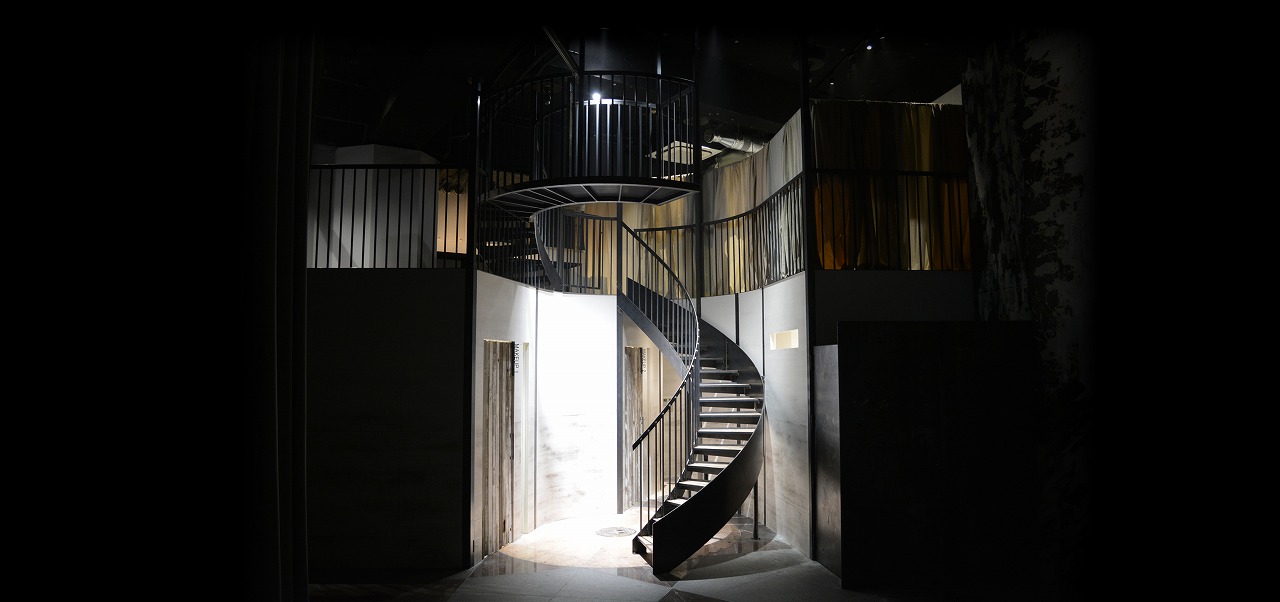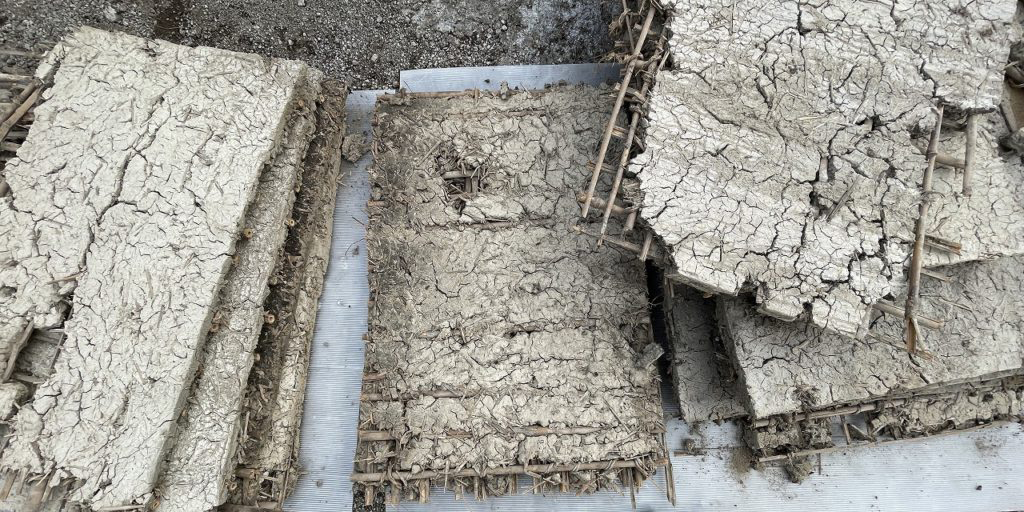想定外を構築する。外築=SOTOCHIKU
人間が人間でいるために、<想定外>を空間の中に取り入れることをめざしてきたGRIDFRAMEが、創業から20年後にたどり着いた手法をSOTOCHIKU(ソトチク)という。
Constructing the unexpected.= SOTOCHIKU
GRIDFRAME has aimed to incorporate the unexpected into spaces so that humans can remain human, and 20 years after its founding, the method it arrived at is called SOTOCHIKU.

この30年程で建材のカタログ化が急速に進み、巷のほぼ全ての空間づくりの材料はカタログから購入され、それらが加工されて「パーツ製品化」され、さらにモノがアセンブルされて「空間化」されている。つまり、通常の空間づくりで行われているのは、次の通りである。
材料購入→パーツ製品化→空間化
GRIDFRAMEはこれに反旗を翻してきた。1998年創業以来、自社工場の存在を活かし素材に独自の加工を加えて「材料化」する、というプロセスにこだわった。つまり、GRIDFRAMEの空間づくりは次の通りである。(独自の材料化プロセスを2010年からMateri-ars(マテリアルス)と呼ぶようになった。)
素材購入→材料化→パーツ製品化→空間化
だが、それで満足していたわけではない。ぼくらには創業当時からある一つの願いがあった。ぼくらは日常の中で道を歩く途中、さまざまな古い壁や塀にさまざまな時間の記憶を発見しては、それらを空間づくりの素材として使用することを夢見ていたのだ。
そのような素材をどうやって集めることができるか、がぼくらの長年の課題だった。寄付控除の仕組みを利用するアイディアを得たのは2018年のこと。ぼくらはこれから壊される建物などから、時間を記憶した素材を寄付で集める仕組みを整えて、この素材採取の活動をSOTOCHIKUと名付けて、2020年からプロジェクトが動き始めた。SOTOCHIKU素材は空間全体の一部に過ぎないが、それでも空間全体に与える影響は絶大だ。
In the last 30 years or so, the cataloging of building materials has progressed rapidly, and almost all materials used to create spaces on the street are purchased from a catalog, processed and turned into “things,” and then these things are assembled and turned into “spaces.” In other words, the usual process of creating spaces is as follows:
Purchase materials → Parts manufacturing → Space creation
GRIDFRAME has rebelled against this. Since its founding in 1998, the company has focused on the process of “materializing” materials by applying its own processing techniques to raw materials, taking advantage of the presence of its own factory. In other words, GRIDFRAME’s spatial creation is as follows. (Since 2010, the company has called its unique materialization process “Materi-ars.”)
Purchase materials → Materialization → Parts manufacturing → Space creation
But we weren’t satisfied with that. We had one wish from the beginning. As we walked down the streets in our daily lives, we discovered memories of different times in various old walls and fences, and dreamed of using them as materials for creating spaces.
How to collect such materials has been a long-standing issue for us. In 2018, we came up with the idea of using a donation tax deduction system. We established a system to collect time-storing materials from buildings that are scheduled to be demolished by donation, named this material collection activity SOTOCHIKU, and started the project in 2020. Although SOTOCHIKU materials are only a part of the entire space, they still have a tremendous impact on the entire space.

ようやくGRIDFRAMEの実力がフルに活かされるときが来た。
素材採取→材料化→パーツ製品化→空間化
このプロセスでできあがった空間を、SOTOCHIKU空間と呼んでいる。
このカタチができたことにより、遠い未来、時間を記憶したSOTOCHIKU空間から、さらに素材採取を行う循環のカタチが見えてきた。
素材採取→材料化→パーツ製品化→空間化→素材採取・・・
The time has finally come to fully utilize GRIDFRAME’s capabilities.
Material collection → Materialization → Parts manufacturing → Space creation
The space created through this process is called ”SOTOCHIKU space”.
By creating this form, we can see a cycle in which further material collection will take place in the distant future from the SOTOCHIKU space, which remembers time.
Material collection → Materialization → Parts manufacturing → Space creation → Material collection…

SOTOCHIKU空間には、三つの想定外がある。
一つ目は、「想定外の素材」である。そのままでは廃棄処分となってしまう、建材になるとは誰も思わなかった<SOTOCHIKU素材>を使う想定外である。
何に出会うか、を事前に知ることはできない。
There are three unexpected things in a SOTOCHIKU space.
The first is “unexpected materials.” It is unexpected to use “SOTOCHIKU materials,” which would otherwise be discarded and that no one would have thought would become building materials.
There is no way to know in advance what you will encounter.

二つ目は、「想定外の制作」である。
出会ったSOTOCHIKU素材をどのような感性で捉え、どのように唯一無二の制作に繋げるかの想定外である。
素材と向き合う前に、制作のゴールや方法を知ることはできない。
The second is “unexpected production.”
It is unexpected how one perceives the SOTOCHIKU materials they encounter and how they can be used to create a unique work.
It is impossible to know the goal or method of production before facing the materials.

三つ目は、SOTOCHIKU空間で時を過ごす人にとっての「想定外の出会い」である。
ぼくらつくり手は、SOTOCHIKU素材のもつ生のエネルギーがつくる過程で失われないように心を配る。ちょうど、料理人が生の食材を調理するときにある栄養素が失われないように心を配るように。
SOTOCHIKU空間で過ごす人々が想定外のモノに一対一で向き合い、それぞれの人が持って生まれた余りある力を発揮できることを願って。
The third is an “unexpected encounter” for those who spend time in a SOTOCHIKU space.
As creators, we take care not to lose the raw energy of the SOTOCHIKU ingredients in the creation process, just as a chef takes care not to lose any nutrients when cooking raw ingredients.
We hope that the people who spend time in a SOTOCHIKU space will be able to face the unexpected one-on-one, and demonstrate the innate powers that they each possess.
